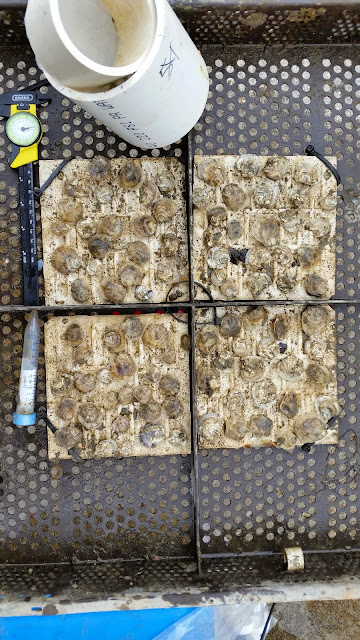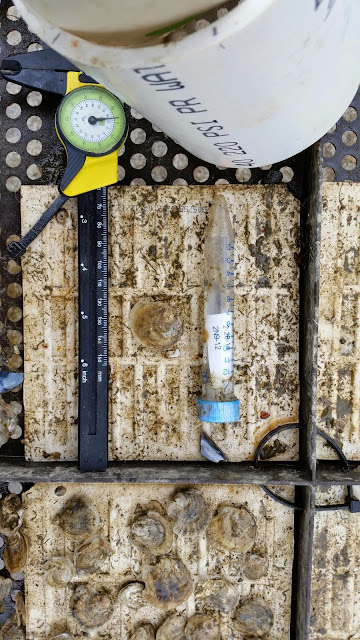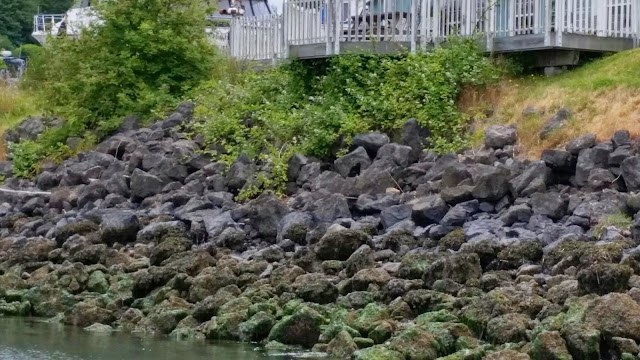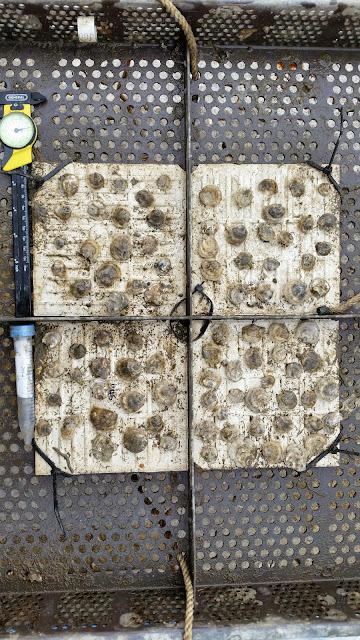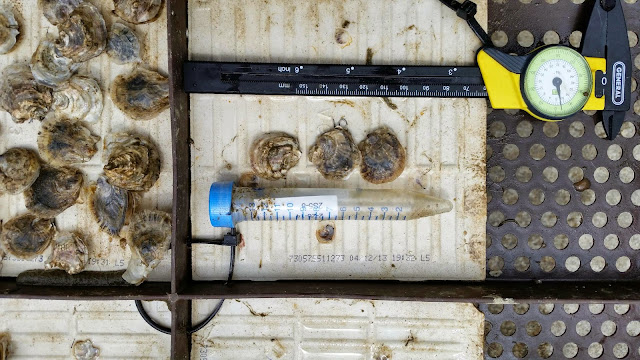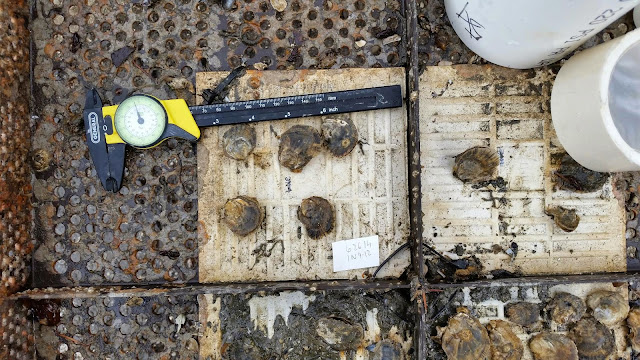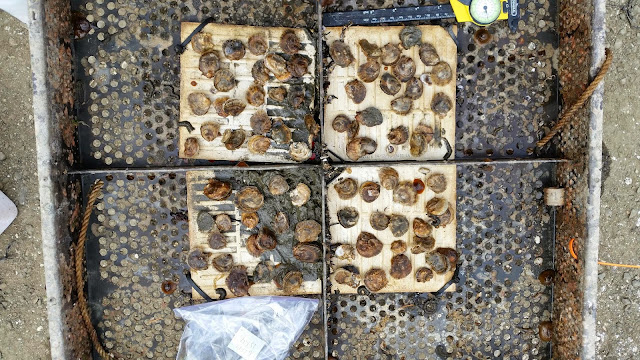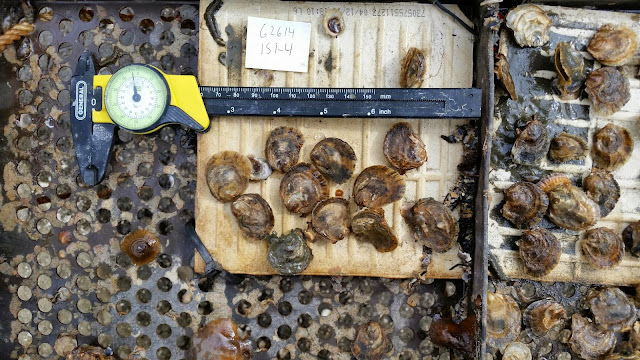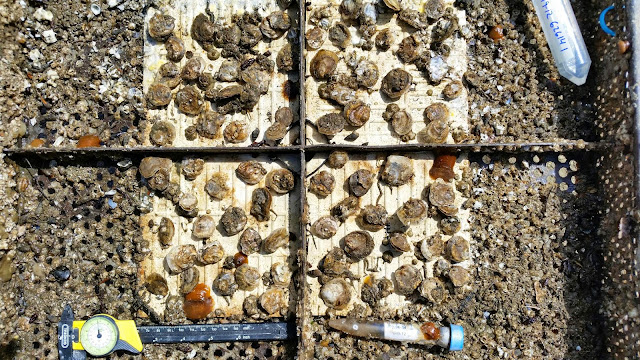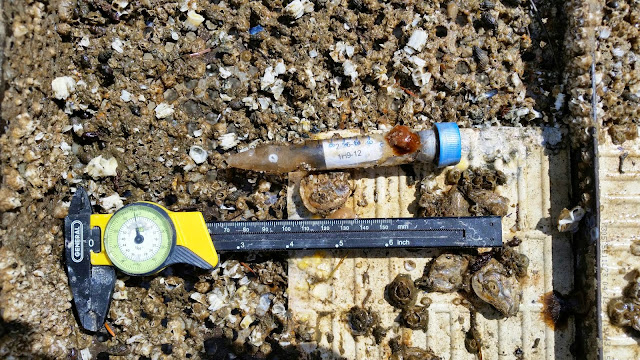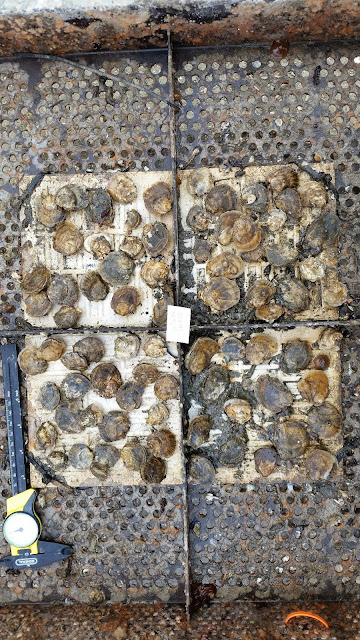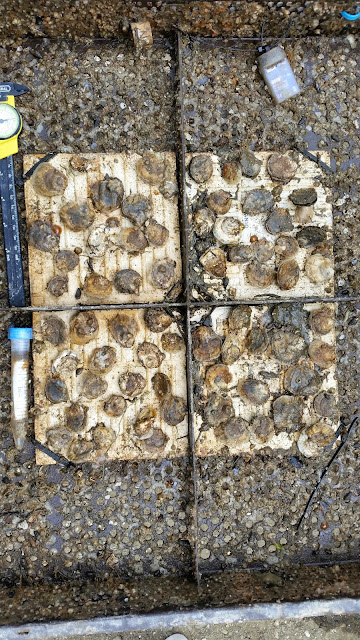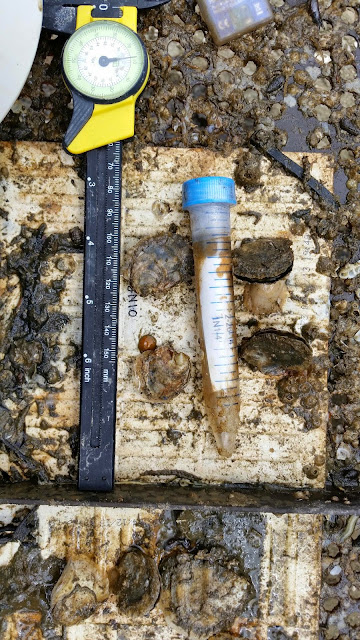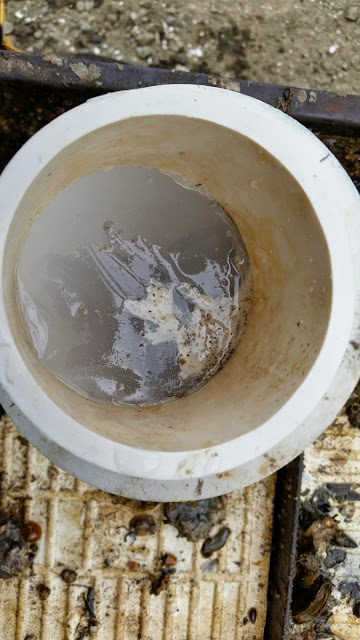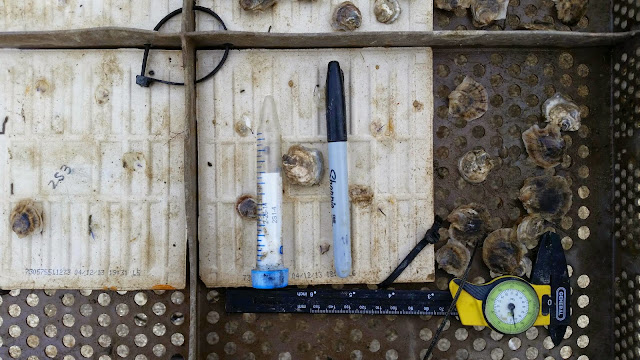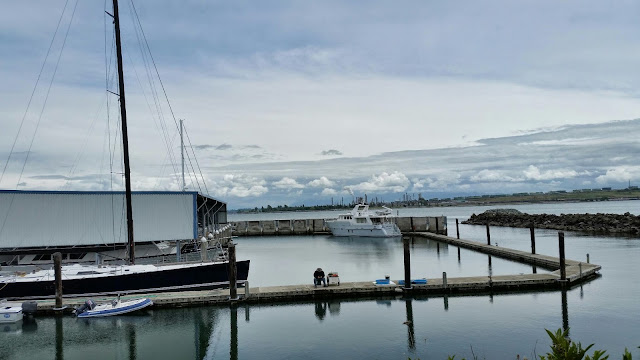Wednesday, July 2, 2014
7 2 2014 Manchester Repro Update
Mid 60's to High 70s Sunny
Participants: L. Christine Savolainen and Jake Heare
Used the Anesthesia SOP with the insulation and ice blocks on the treatment tubs. Found absolutely no brooders. This site just does not have the conditions necessary for these animals to spawn. It must be due to the colder deep water that comes into the bay off the Sound.
Numbers as Follow:
Temps in C
Pretreatment
Initial 10
45 min 11
1.5 hr 15 * sun came out
Treatment
Initial 11
45 min 11
1.5 hr 10
2.25 9
Recovery
Initial 11
45 min 13
1.5 hr 15
Salinity in ppt
Pretreatment 28
Treatment 67
Recovery 28
Brood Collection
4H9-12
Brood 0
Gaping 52
Dead 20
Closed 8
4S13-16
Brood 0
Gaping 31
Dead 4
Closed 48 *Lots of boat traffic shaking the dock
4N1-4
Brood 0
Gaping 40
Dead 20
Closed 18
Monday, June 30, 2014
6 30 2014 June Survivorship Data
All numbers are for living animals only.
| Oyster Bay | N | H | S |
| 1-4 | 73 | 86 | 97 |
| 5-8 | 63 | 56 | 0 |
| 9-12 | 85 | 97 | 1 |
| 13-16 | 0 | 12 | 93 |
| Total | 221 | 251 | 191 |
| Manchester | N | H | S |
| 1-4 | 90 | 96 | 65 |
| 5-8 | 95 | 92 | 93 |
| 9-12 | 61 | 89 | 98 |
| 13-16 | 87 | 79 | 94 |
| Total | 333 | 356 | 350 |
| Fidalgo | N | H | S |
| 1-4 | 96 | 93 | 93 |
| 5-8 | 97 | 99 | 93 |
| 9-12 | 93 | 87 | 97 |
| 13-16 | 110 | 91 | 87 |
| Total | 396 | 370 | 370 |
| Total Brooders | Manchester | Oyster Bay | Fidalgo |
| N | 1 | 15 | 2 |
| H | 1 | 5 | 0 |
| S | 1 | 32 | 11 |
| 1st brood | 6/18/2014 | 5/29/2014 | 6/6/2014 |
| *1N trays were sampled twice in one sample date |
| Percent Brood | Manchester | Oyster Bay | Fidalgo |
| N | 0.30% | 6.79% | 0.51% |
| H | 0.28% | 1.99% | 0.00% |
| S | 0.29% | 16.75% | 2.97% |
6 30 2014 South Sound Survivors
Pop Live
North 221
Dabob 251
South 191
Tray Break Down is such:
| South Sound | |||
| N | H | S | |
| 1-4 | 73 | 86 | 97 |
| 5-8 | 63 | 56 | 0 |
| 9-12 | 85 | 97 | 1 |
| 13-16 | 0 | 12 | 93 |
| Total | 221 | 251 | 191 |
Friday, June 27, 2014
6 27 2014 fidalgo repro check
Initial. 9
45. 10
1.5. 10
Initial. 9
45. 10
1.5. 10
2.25. 12
Initial. 10
45. 10
1.5. 14
Pretreatment. 29
Treatment. 58
Recovery. 28
Brood. 3
Gaping. 87
Dead. 0
Closed. 6
# size. Sick
1. 27. W
2. 25. W
3. 26. W
Brood. 0
Gaping. 65
Dead. 0
Closed. 28
Brood. 1
Gaping. 87
Dead. 0
Closed. 6
# size. Sick
1. 31. W
Thursday, June 26, 2014
6 26 2014 oyster bay repro
Used the modified anesthesia sop with insulation and ice blocks. Collected from the water the lost stack as well as the hhn stack to reshuffle oyster trays. Big things of note, 1 south sound tray was 99% dead. It was a middle tray, had no predators and no fouling. No idea why those animals died but the other two trays in the stack survived. Brooding in all sampled trays seemed to have followed expectations. With no pop with way more or way less brooders than expected. Also collected temp logger info. All trays were kept in ambient seawater during Pretreatment or out plant if not sampled
Lost trays marked with orange ziptie, hhn trays labeled with blue ziptie.
Numbers as follows:
Temps in c
Pretreatment
Initial. 14
45. 14
1.5. 14
2.25. 16
Treatment
Initial. 11
45. 11
1.5. 11
2.25. 9
3. 8
Recovery
Initial. 13
45. 15
1.5. 16
2.25. 16
Salinity
Pretreatment. 26
Treatment. 68
Recovery. 24
Trays not used for Brood collection
1S9-12
Live. 1
Dead. 82
1H13-16
Live. 12
Dead. 0
Brood collection
1N1-4. From hhn stack
Brood. 2
Gaping. 72
Dead. 10
Closed. 1
Brooders
# size. Sick
1. 25. W
2. 31. Grey
(Three previous trays were put out immediately as stack 1. Far left from shore)
1H9-12
Brood. 1
Gaping. 92
Dead. 4
Closed. 1
Brooders
# size. Sick
1. 27. Grey
1S1-4
Brood. 11
Gaping. 85
Dead. 10
Closed. 2
Brooders
# size. Sick
1. 29. W
2. 25. W
3. 28. W
4. 30. W
5. 26. W
6. 30. W
7. 25. W
8. 26. W
9. 28. W
10. 31. W
11. 27. W
10/11. Were dirty samples, had lots of mud mixed in with larvae.
1N9-12
Brood. 5
Gaping. 84
Dead. 16
Closed. 1
Brooders
# size. Sick
1. 31. W
2. 29. W
3. 36. W
4. 28. W
5. 30. W
Wednesday, June 25, 2014
6 25 2014 Manchester Repro Check
Mid 60's to mid 70s sunny
Participants: L. Christine Savolainen and Jake Heare
Performed the Anesthesia SOP modified with insulation on the treatment tub as well as ice blocks to keep temperatures within range. Found one brooder in the Northern population with minimal larvae and found one brooder from Dabob that had a very strange mix of eggs and what appeared to be semen. This might be evidence for an abortive spawn. also collected all mortalities from trays.
numbers as follow.
Temps in C
Pretreatment
Initial 10
45 min 15
1.5 hr 15
Treatment
Initial 11
45 min 11
1.5 hrs 11
2.25 hr 11
Recovery
Initial 10
45 min 15
1.5 hr 17
Salinity
Pretreatment 27
Treatment 65
Recovery 21
Brood Collection
4S1-4
Brood 0
Gaping 50
Dead 22
Closed 13
4N5-8
Brood 1
Gaping 53
Dead 23
Closed 19
Brooders
# size sick
1 25 w
4H5-8
Brood 1
Gaping 52
Dead 7
Closed 33
Brooders
# size sick
1 15 W
 |
| Harbor Seal watching us work all day. |
Friday, June 20, 2014
6 20 2014 fidalgo repro check
Pretreatment.
Initial. 8
45 min. 8
1.5 hrs. 9
Initial. 9
45 min. 9
1.5 hrs. 10
2.25 hrs. 10
Initial. 7
45 min. 8
1.5 hrs. 8
Pretreatment. 35
Treatment. 65
Recovery. 35
2S1-4
Brood. 1
Gaping. 83
Dead. 0
Closed. 10
Brooders
# size. Sick
1. 27. W
Brood. 0
Gaping. 77
Dead. 0
Closed. 10
Brood. 0
Gaping. 76
Dead. 0
Closed. 34
